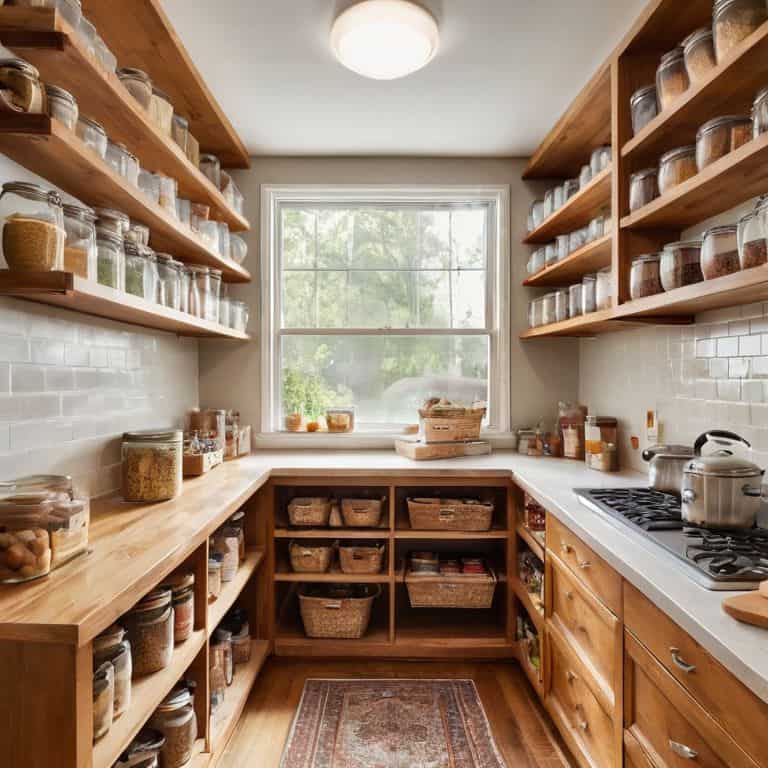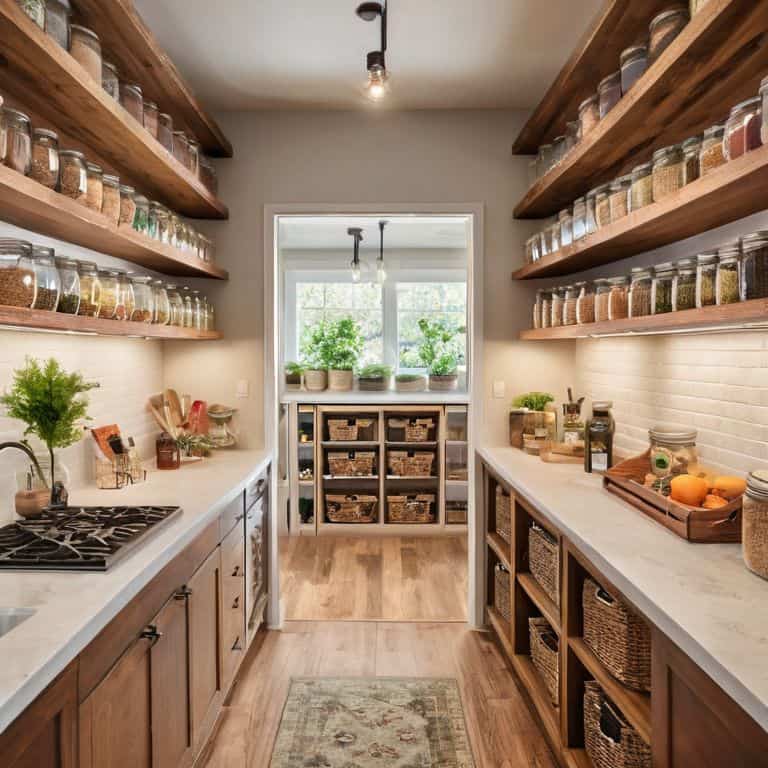I still remember the day I realized that a well-designed kitchen isn’t just about aesthetics; it’s about functionality. I was struggling to find ingredients in my own cluttered pantry, and it hit me – a guide to creating a walk-in pantry would be a total game-changer. Having a dedicated space for all my cooking essentials would make meal prep a breeze and inspire me to try new recipes. As someone who’s passionate about cooking and interior design, I’ve learned that a walk-in pantry is more than just a luxury – it’s a necessity for any serious home cook.
In this article, I’ll share my expertise on creating a walk-in pantry that’s both beautiful and functional. You’ll learn how to assess your space, choose the right materials, and design a layout that works for you. I’ll provide you with practical tips and real-life examples to help you overcome common obstacles and create a pantry that reflects your personal style. Whether you’re a seasoned cook or just starting out, this guide will give you the confidence to create a walk-in pantry that nourishes both body and soul.
Table of Contents
- Guide Overview: What You'll Need
- Step-by-Step Instructions
- A Guide to Creating a Walk in Pantry
- Illuminating Your Space With Walk in Pantry Lighting Ideas
- Maximizing Storage With Custom Pantry Shelving
- Bringing Your Walk-In Pantry to Life: 5 Essential Tips
- Key Takeaways for Your Dream Walk-In Pantry
- Pantry Wisdom
- Bringing Your Dream Pantry to Life
- Frequently Asked Questions
Guide Overview: What You'll Need

Total Time: 8 hours 30 minutes
Estimated Cost: $500 – $1000
Difficulty Level: Intermediate
Tools Required
- Circular Saw (for cutting lumber)
- Drill Press (for precise drilling)
- Hand Saw (for cutting small pieces)
- Level (for ensuring shelves are level)
- Measuring Tape (for accurate measurements)
- Pencil and Marking Tool (for marking cut lines)
- Sandpaper (for smoothing out wood surfaces)
- Screwdriver (for driving screws)
- Utility Knife (with extra blades)
Supplies & Materials
- 2-in x 4-in lumber (for framing the pantry)
- 3/4-in plywood (for shelving)
- 1/2-in drywall (for lining the pantry walls)
- Drywall Screws (for attaching drywall to studs)
- Wood Screws (for assembling shelves)
- Hinges (for attaching doors)
- Magnetic Catch (for securing doors)
- Shelf Brackets (for supporting shelves)
- Backsplash Material (for protecting walls from moisture)
- Paint or Stain (for finishing the pantry interior)
Step-by-Step Instructions
- 1. First, assess your space by measuring the area where you plan to create your walk-in pantry. Consider the _layout of your kitchen_ and how the pantry will fit into your overall workflow. Think about the _kitchen work triangle_ and how your pantry can support this efficient design principle.
- 2. Next, _define your needs_ by making a list of the items you want to store in your pantry. This will help you determine the type and amount of _storage solutions_ you’ll require. Consider the types of food you cook with most often and the _cooking utensils_ you use regularly.
- 3. Now, design your pantry by sketching out a basic floor plan and elevation. Think about the _shelf layout_ and how you can maximize your vertical space. Consider installing _adjustable shelves_ to accommodate items of different sizes and make the most of your storage capacity.
- 4. Choose your _materials and finishes_ carefully, as they will greatly impact the overall look and feel of your pantry. Select materials that are _durable and easy to clean_, such as hardwood or laminate, and consider adding a _stylish backsplash_ to protect your walls from spills and splatters.
- 5. Install your _shelving and storage units_ according to your design plan. Make sure to leave enough space between shelves for easy access and consider adding _pull-out drawers_ or _basket storage_ for additional functionality.
- 6. Add _lighting that inspires_ to your pantry, such as under-shelf lighting or a stylish pendant light. This will not only make your pantry more functional but also create a warm and inviting atmosphere that makes you want to cook and _get creative in the kitchen_.
- 7. Finally, organize your pantry by grouping similar items together and using _labels and signs_ to keep everything easily identifiable. Consider implementing a _”first in, first out”_ policy to ensure that older items are used before they expire and make the most of your _pantry’s potential_.
A Guide to Creating a Walk in Pantry

As I always say, a well-designed pantry is the heart of a functional kitchen. When it comes to creating a walk-in pantry, custom pantry shelving designs can make all the difference. Consider investing in adjustable shelves to maximize pantry storage space and accommodate items of varying sizes. This will not only keep your pantry organized but also ensure that your ingredients and cooking essentials are easily accessible.
To take your walk-in pantry to the next level, think about maximizing pantry storage space with clever storage solutions. This can include installing baskets, bins, or drawers to store dry goods, spices, and other kitchen staples. Don’t forget to consider walk-in pantry lighting ideas that will illuminate your space and make it feel more inviting. Proper lighting can also help you spot expired or spoiled ingredients, keeping your pantry fresh and safe.
When it comes to maintaining your walk-in pantry, optimal pantry temperature control is crucial. Aim for a consistent temperature between 50-70°F (10-21°C) to preserve the quality and freshness of your stored ingredients. Additionally, consider pantry door design options that will keep your pantry organized and clutter-free. A stylish and functional pantry door can make a big impact on the overall aesthetic of your kitchen, making it a joy to cook and entertain in.
Illuminating Your Space With Walk in Pantry Lighting Ideas
When it comes to walk-in pantry lighting, I always say, “layer it up!” A combination of overhead lighting, shelf lighting, and even floor-level lighting can create a warm and inviting ambiance. I love using LED tape lights under shelves to highlight my favorite cookbooks and decorative ceramics. For a more dramatic effect, consider installing pendant lights or a show-stopping chandelier to make your pantry feel like a true destination.
To really make your pantry shine, don’t forget about task lighting. Under-cabinet lighting can help illuminate specific storage areas, like a coffee or spice station. And, let’s not overlook the power of natural light – if possible, position your pantry near a window to flood the space with warmth and energy. Proper lighting can truly elevate your walk-in pantry from a mere storage space to a culinary haven.
Maximizing Storage With Custom Pantry Shelving
To truly maximize storage in your walk-in pantry, custom shelving is the way to go. I just love designing shelves that fit my clients’ unique needs – from adjustable spice racks to built-in wine storage. By tailoring your shelving to your cooking style, you can ensure that every item has its perfect place. For instance, if you’re a avid baker, consider dedicating a entire shelf to your mixing bowls, utensils, and ingredients.
Investing in custom pantry shelving may seem like a splurge, but trust me, it’s worth it. Not only will it keep your pantry organized and clutter-free, but it’ll also make cooking and meal prep a total breeze. Plus, it’s a great opportunity to add some personal style to your pantry – think decorative brackets, reclaimed wood, or sleek glass shelves. Whatever your design aesthetic, custom shelving can help bring your walk-in pantry to the next level.
Bringing Your Walk-In Pantry to Life: 5 Essential Tips
- Optimize Your Floor Plan: Consider the kitchen work triangle when placing your walk-in pantry to ensure a seamless cooking experience
- Select the Right Shelving: Choose between adjustable, fixed, or a combination of shelving to maximize storage and accommodate items of varying sizes
- Lighting Makes a Difference: Incorporate a mix of overhead lighting, shelf lighting, and task lighting to create a warm and inviting atmosphere
- Label and Categorize: Implement a labeling system and categorize your pantry items to maintain organization and make the most of your storage space
- Add a Personal Touch: Incorporate decorative elements, such as vintage kitchenware or greenery, to make your walk-in pantry a reflection of your personal style and a joyful space to cook and create
Key Takeaways for Your Dream Walk-In Pantry
By incorporating a thoughtful layout and custom shelving, you can maximize storage and efficiency in your walk-in pantry, making cooking and meal prep a joy
Effective lighting is not just about brightness, but also about ambiance – consider layering different light sources to create a warm and inviting atmosphere in your pantry
A well-designed walk-in pantry is not just a practical space, but also a reflection of your personal style and cooking philosophy – don’t be afraid to add decorative touches and personality to make it truly yours
Pantry Wisdom
A walk-in pantry is more than just a storage space, it’s the heartbeat of your kitchen, where every ingredient, tool, and recipe comes together in perfect harmony to nourish both body and soul.
Clara Wu
Bringing Your Dream Pantry to Life

As we’ve explored in this guide to creating a walk-in pantry, the key to a successful design lies in striking a balance between form and function. We’ve discussed the importance of maximizing storage with custom shelving, as well as illuminating your space with thoughtful lighting ideas. By incorporating these elements, you’ll be well on your way to crafting a pantry that not only meets your practical needs but also inspires your culinary creativity. Whether you’re a busy home cook or an avid entertainer, a well-designed walk-in pantry can be a game-changer for your daily routine and special occasions alike.
As you embark on your own pantry design journey, remember that the goal is to create a space that nourishes both body and soul. Don’t be afraid to think outside the box and infuse your pantry with personal touches that reflect your unique style and cooking philosophy. With a little creativity and planning, you can turn this often-overlooked area into a haven of inspiration that sparks joy and deliciousness in all who enter. So go ahead, get creative, and watch your walk-in pantry transform into the heart of your home!
Frequently Asked Questions
How can I determine the ideal size and layout for my walk-in pantry to maximize storage and efficiency?
To determine the ideal size and layout for your walk-in pantry, consider the kitchen work triangle and your personal cooking style. Measure your most-used items and group similar ones together. Think about narrow aisles and ample shelf space – I recommend at least 24-30 inches of width for easy navigation.
What are some creative ways to utilize the often-wasted space behind pantry doors or in corner areas?
I love uncovering hidden gems in kitchen design. For the space behind pantry doors, consider installing a spice rack, pegboard, or even a chalkboard for meal planning. In corner areas, opt for a carousel or a pull-out basket to maximize storage and keep essentials within easy reach.
Are there any specific lighting design principles or fixtures that can help make the most of a walk-in pantry's unique dimensions and storage needs?
For a walk-in pantry, I swear by layered lighting – a combo of overhead LED strips, under-shelf lighting, and warm spotlights to highlight favorite ingredients. This creates a bright, welcoming space that makes it easy to find what you need. Plus, it’s just so pretty!
